Despite having lived in China for 12 or so years (a fact I sometimes bring up), I had up until recently done comparatively little travelling in the country. Xinjiang in particular had never really appealed to me; this could have been due to my innate tendency towards sloth or the fact that many Han Chinese frequently characterise the province as ‘dangerous’.
After recently changing my vocation from TEFL teacher to YPT guide, however, the opportunity to visit Xinjiang came up. Out of a combination of curiosity and contractual obligation, I decided not to let this chance slip by.
Here’s the image I had of Xinjiang before I went: hot, dusty, fantastic food, lots of mosques, and a people viewed with suspicion by your average Han Chinese.
With my unsubstantiated preconceptions nestled firmly in my mind, I packed my bag, boarded my plane and headed for Kashgar. Here’s how the reality differed to what I thought.
Xinjiang is the most security-heavy place I’ve ever been to
A few months ago I visited Tibet, and I thought that was pretty heavily policed: security checkpoints abounded, carrying one’s passport was mandatory and there was a strong police presence in Lhasa.
Tibet has nothing on Xinjiang.
Every city in Xinjiang had multiple security checkpoints scattered about, complete with metal detectors and bag scanners. Not only this, but every hotel and restaurant sported the same security, complete with ‘riot police’. When travelling by car, expect multiple stops to have your passport verified. Every single shop, whether a convenience store or a supermarket, had a magnetically locked security gate at the entrance.
The amount of security on display was, frankly, overwhelming. One fringe bonus of being a foreigner was that we were quite often waved through city checkpoints, because as we all know, white people never commit terrorist atrocities.
Mandarin is little-spoken
One of the reason I do China tours is because after 12 years (sometimes I mention that), I have a reasonable facility with the language. This comes in handy most of the time; even in Tibet, most locals can speak Mandarin to some extent.
Not so in Xinjiang. Even in high-scale restaurants, there was little in the way of Mandarin (or English). This was a cause of consternation to me, as being a Mandarin-speaking white guy is what I have in place of a personality.
The mosques are not quite what expected
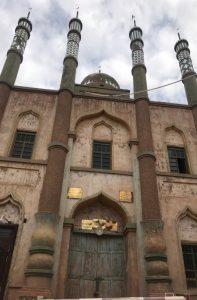
When you think of a mosque, a certain image springs to mind. Minarets, domes, curvy windows, the whole nine yards. They have most of these things on Xinjiang mosques. They also have Communist Party slogans above the entrances (“Love the country, love the party”), quite often sport stripped-out interiors, and in certain cases have been converted into bars. As you can imagine, this is extremely offensive to Muslims.
The most particularly notable example of this phenomenon is the Id Kah Mosque in Kashgar. Beautiful and imposing on the exterior, the mosque basically doesn’t exist inside. There is a white room with a couple of carpets and a bunch of Han tourists. Don’t pay to go inside the Id Kah Mosque, is what I’m saying.
Xinjiang’s scenery is breath-taking
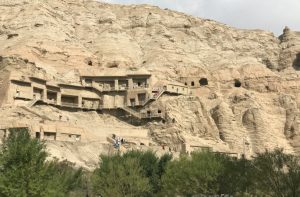
You’d think you could only get so much mileage out of sand and rocks. Xinjiang, however, takes sand and rocks and just runs with it.
Just outside of Kashgar lies the Taklamakan Desert, renowned as the sandy tomb of a thousand merchants and explorers. For around 150 RMB you can make merry sport in this most feared of places by hiring a dune truck and indulging in what is basically an off-rails rollercoaster. Out in the desert, you can continue the possibly inappropriate fun in this place of death by sand-tobogganing!
If you’re interested in the exploits of larcenous Western explorers/archaeologists, however, then the cities of Kuqa and Turpan will be right up your alley. Outside Kuqa is the Cave of a Thousand Buddhas, where you can see a distinct lack of Buddhas. Rendered more accurately as the ‘Cave of a couple dozen Buddhas’, German archaeologists did a number here, cutting frescoes out of the cave walls and transporting them back to Germany.
Outside Turpan you can visit a Uyghur mud-walled village. Somewhat Disneyfied in nature (and this was a bit of a theme throughout the province), the village was the one-time home of Albert von le Coq, plunderer of the formerly mentioned Cave of a Thousand Buddhas.
And also outside of Turpan you can find perhaps the most spectacular sites in Xinjiang: the Gaochang Ruins and the (Chinese) Grand Canyon.
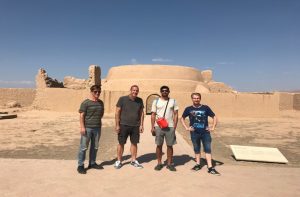
The Gaochang Ruins are nothing short of spectacular. At the entrance you are offered the choice of an optional shuttle bus; after much dithering, my group and I opted to take it. It turns out that the options are as follows: take the shuttle bus, or die of thirst and exposure. The Gaochang Ruins are massive, and it would take you the entire day to fully explore them on foot. Under the desert sun, this is highly inadvisable. We even got the added bonus of a thoroughly hilarious group of Han tourists who took way too many pictures. This was more fun than it sounds.
China’s Grand Canyon is also quite the sight. Whilst nowhere near as famous as its occidental counterpart, the canyon is a fantastic location in its own right, and is nicely rounded off by several tacky tie-in monuments for China’s great work of literature, ‘Journey to the West’. You can even get hardboiled eggs here that have been cooked by nothing more than the awesome power of the sun.
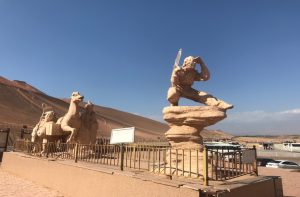
The food really is fantastic
I spoke a bit earlier about Xinjiang food, and it’s no exaggeration to say that they have some of the best food in China there. Xinjiang food is renowned primarily for two things: massive skewers of lamb and da pan ji, which literally translates as ‘big plate of chicken’. The big plate of chicken comes chocked with potatoes, peppers, noodles, and of course huge chunks of chicken. Add to this nan bread, a huge variety of spicy noodle dishes and a bunch of Central-Asian-influenced dishes (also heavy on the lamb; some yoghurt may be involved) and you have a culinary party in your mouth.
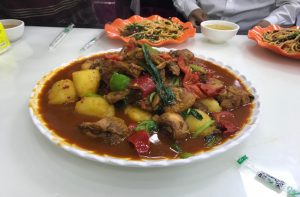
And there we have it. Is Xinjiang worth a visit? Absolutely. It’s like no other part of China and, indeed, quite often doesn’t even seem like a part of China. Xinjiang is a region rich in culture and heritage, and it sports some absolutely spectacular sights that are well worth your time.
Sign up for next year’s Xinjiang Far West tour!







